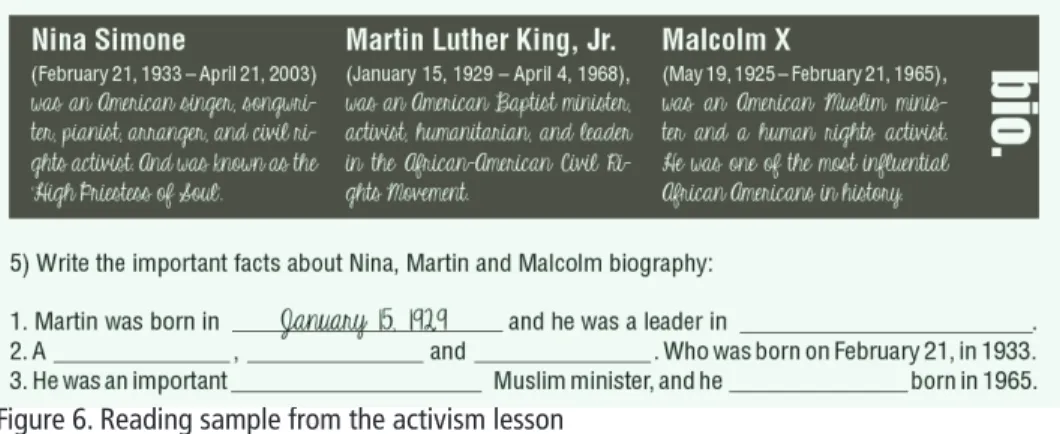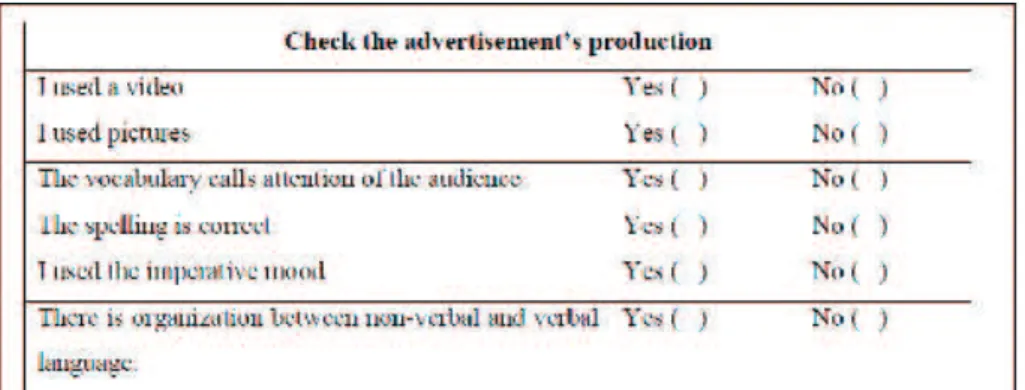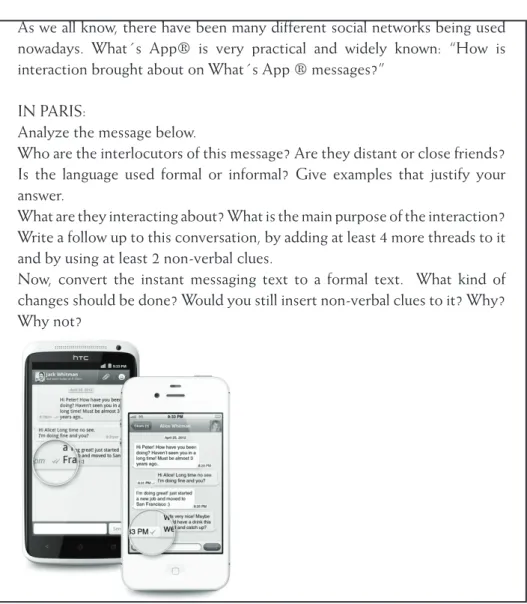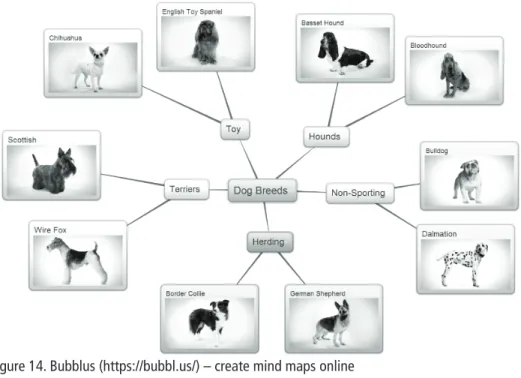CLASS ACTIVITIES OF A GENRE-BASED APPROACH
TO TEACHING ENGLISH AS A FOREIGN LANGUAGE
A ESCRITA COMO UMA ATIVIDADE SOCIALMENTE
RELEVANTE: AMOSTRAS DE ATIVIDADES DA SALA DE AULA
DE LÍNGUA INGLESA EM UMA ABORDAGEM BASEADA EM
GÊNEROS
Marisa Mendonça Carneiro
*Ana Larissa Adorno Marciotto Oliveira
*ABSTRACT
This papers aims at discussing some principles of a genre-oriented approach to foreign language teaching from the perspective of Functional Linguistics. We also argue in favor of the relevance of using technological tools to enrich writing pedagogy. To do that, we analyze some sample in-class activities that come from two different educational contexts: a Diploma course intended to English teachers in continuing education and a course on academic writing, designed to medical graduate students. Our findings point to the significance of combining a process and a product-oriented approach to writing, including instruction; text revision and rewriting; and scaffolding. Finally, we make the case that a functional view of language should underpin a genre-oriented pedagogy, as it opens room for analyzing language as a social enterprise.
Keywords: academic writing; functional view of language; English as a foreign language RESUMO
Este trabalho tem por objetivo discutir alguns princípios da abordagem de ensino de línguas baseado em gêneros textuais pela visão da linguística funcional. A relevância do uso de ferramentas tecnológicas para enriquecer o ensino de escrita também é defendida. Para isso, analisamos amostras de atividades de sala de aula, oriundas de dois contextos diferentes: um curso de especialização destinado a professores de inglês em educação continuada e um curso de escrita acadêmica, voltado para alunos da pós-graduação da área de Medicina. Os resultados apontam para a importância de combinar a escrita como processo e a escrita como produto, o que inclui a instrução; a revisão e a reescrita de textos, bem como o
scaffolding. Finalmente, defendemos que uma visão funcional da linguagem é importante para sustentar a pedagogia baseada em gêneros, já que ela abre caminho para a análise da língua como uma tarefa socialmente relevante.
Palavras-chave: escrita acadêmica; visão funcional da linguagem; inglês como língua estrangeira
InTROdUCTIOn
In Communicative ELT (English Language Teaching), text genre analysis is essential to uncover the social and the cultural basis of language. The notion of genre has largely drawn the attention of many scholars. It is incontestable that a genre-based approach to teaching greatly improves learners’ skills, not only in academic settings, but also in professional scenarios (EGGINS, 2004). A genre-oriented approach to language teaching incorporates an understanding that language is purposeful and that structures emerge from use (HALLIDAY, 2004). Additionally, there is an increasing recognition of the relevance of taking into consideration language varieties, text-types, and text genres while designing reading and writing language programs (THORNE and REINHARDT, 2008).
As Martin (2002) points out, genres have been defined as staged, goal-oriented social processes. In these terms, as a level of context, genres represent ‘the system of staged goal-oriented social processes through which social subjects in a given culture live their lives’ (MARTIN, 2002, p. 56). In ELT, the concept of text genre sheds light on the influence of the context of culture on language. From that viewpoint, every culture structures particular ways of achieving communication goals in a given context through the production of written and oral texts.
The fact that English is considered the predominant language for communicating research findings makes it paramount that users of English as a Foreign Language (EFL) develop proficiency in research English across the skills of reading and writing (SWALES and FEAK, 2009; SWALES, 2004). In order to be part of the scientific community, EFL researchers need to understand ‘the social processes by which knowledge about reality and the world are made’ (PALTRIDGE, 2014, p. 303), that is, they need to be able to understand several genres that are part of academic social practice. Failure to understand written genres as social action may result in instruction that encourages the creation of texts to fit formal requirements, as opposed to the practice of achieving social goals (PALTRIDGE, 2014).
The aim of this paper is to discuss some principles of genre-oriented approaches to language teaching from the perspective of Functional Linguistics. We also highlight the relevance of using technological tools to enrich the teaching of writing. To do that, we present and analyze some sample in-class activities that we believe follow genre-based principles to teaching. These activities come from two different educational contexts: a Diploma Course (CEI FALE UFMG1), intended
to teachers in continuing education, and course on academic writing, intended to medical graduate students.2 Before we can present these in-class activities, we will
discuss the theoretical foundation that underpins our view of teaching writing in both the general context, as well as in the academic scenario.
1. ThE InTERpLAy BETwEEn fUnCTIOnALISM And A gEnRE-ORIEnTEd AppROACh TO TEAChIng
Functionalism views language as a means to create and share knowledge. According to Thompson (2014), the functional approach to language is increasingly being recognized as providing a very useful descriptive and interpretive framework for viewing language as a strategic, meaning-making resource. It encompasses the analysis of authentic products of social interaction, within a particular social and cultural context. The author also highlights that, from a functional viewpoint, the term ‘function’ can be interpreted in at least 3 senses:
– Grammar is designed to explain how language is used.
– Fundamental components of meaning are functional components.
– Each element of language is explained in reference to its function in the global linguistic system.
In this view, grammar meanings are not considered as a collection of rules. They are contextualized and are associated with the practical uses which language is put to. Texts are thus considered authentic products of social interaction, negotiated within a particular cultural and social context. From this perspective, functionalists
1 CEI (Curso de Especialização em Inglês - FALE UFMG) is a Diploma Course intended to English teachers in continuing education. The sample activities we analyzed in this paper were taken from some of the final papers produced in this study, from 2011-2015. Their full version is available at: http://150.164.100.248/cei/.
usually ask questions such as: “How is language structured for use”? According to Thompson (2014), an adequate response to this question may be:
Language is as a system of meanings accompanied by the forms through which those meanings are expressed.
Another important question to be posed by functionalists is “How are texts (and the other linguistic units which make them up, such as sentences or clauses) structured so that meanings can be made? ”The answer to this question includes the three key dimensions of the situations impacting genre analysis. According to Halliday (2004), these 3 dimensions are:
a. The register variables of mode (speaking or writing, verbal, non-verbal)
b. Tenor: role relations of power and solidarity speaking to whom (teacher/student) c. Field: topic or focus of the activity - the theme (weather/family life)
These 3 dimensions are also very relevant because they derive from the 3 meta-functions proposed by (HALLIDAY, 2004), which can be briefly described as:
a. Ideational/experiential (used to tell about subject matter) – refers to the internal or external worlds. Key element in genre analysis: FIELD
b. Interpersonal (used to interact with other people) - expresses the writer’s role; the kind of relationship with the reader; and the writer’s attitude towards the subject matter. Key element in genre analysis: TENOR
c. Textual (to structure the text) - refers to the way the text is organized as a piece of writing (spoken, written, non-verbal). Key element in genre analysis: MODE
Drawing on Halliday’s model of language (Halliday 2004), Butt et al. (2003) have also very clearly outlined the 3 meta-functions, making the case that “use” is essential for any genre-based analysis:
1. Language has a representational function and it is used to encode the personal experience of the world; it conveys a picture of reality. Thus, it allows encoding meanings of experience, which realize the field of discourse (EXPERIENTIAL MEANING).
allows encoding meanings of attitudes, interaction and relationships that realize tenor of discourse (INTERPERSONAL MEANING).
3. Language has a textual function and it is used to organize experiential and interpersonal meanings of text development, which realize mode of discourse. A focus on Theme/Rheme and Given/New Structure is a major feature of this metafunction (TEXTUAL MEANING).
As we can see, the notion of genre is intertwined with a view of language as a purposeful enterprise; as a matter of fact, a functional view of language may be translated into genre-based writing pedagogy. In the next section we will present how the notion of genre can be applied to EFL by discussing writing as a process and product as we outline the tenets of genre-based approach to writing.
2. wRITIng AS A pROCESS And AS A pROdUCT
Writing in a foreign or second language can be approached by two competing, yet not mutually exclusive views: one that emphasizes the product over the process of writing and a second that engages learners in the discovery of ideas by emphasizing the processes of brainstorming, sharing ideas and collaborating in order to produce written texts. On the one hand, learners may benefit from being exposed to the conventions of written discourse by means of studying exemplars of a given genre as well as guidelines on how to construct texts, while risking following imposed models. On the other hand, learners may engage in identifying their own personal writing style and giving their own voice to texts they produce, while not being aware of social written conventions. A combination of both approaches would be ideal, without neglecting the process of writing and relying exclusively on product.
figure 1. a flowchart of the reading process (hyLAnd, 2008: 100)
As the flowchart shows, process writing is a recurrent process, with constant revisions and rewritings, planning and editing in a recursive cycle. EFL teachers need to set pre-writing activities for brainstorming ideas and structure, encourage outlining, provide students with challenging writing tasks, encourage peer correction and give feedback on drafts, and finally provide a final correction (HYLAND, 2008).
According to Paltridge (2014), process writing was thought to not prepare learners to the demands of writing in academic contexts. Indeed, encouraging learners to brainstorm, revise, rewrite and allowing them to create their own writing style was not enough to drive learners to notice the conventions of academic written texts and thus be able to produce texts that would comply with academic conventions. In the 1980’s, genre-based pedagogy came into prominence in the United States as a response to the perceived problems of process writing. Schools in Australia also operated similar change in their writing pedagogies.
Genre based teaching (SWALES, 2004; HYLAND, 2007, 2008) sees text as discourse, or as “the way we use language to communicate, to achieve purposes in particular situations” (HYLAND, 2008, p. 93). It is anchored on the idea that one needs to understand and use language to achieve social purposes in a given context (HYLAND, 2007). As previously mentioned, teaching learners to recognize, analyze and produce written genres will help them participate in academic, occupational and social context in the real world (Hyland, 2007).
produce well-formed and appropriate texts. Hyland (2008) proposes the learning cycle as an approach to teaching writing (FIG. 2):
figure 2. The teaching learning cycle (hyLAnd, 2008, p. 96)
The learning cycle assists teachers in planning instruction by approaching learning to write genres as a series of stages. In a nutshell, the stages lead learners into understanding the purposes of genre (the why, who, to whom, what for and when) as well as degrees of formality; analyzing and modelling the stages and key features (including tenses, themes, vocabulary); supporting students in constructing texts; monitoring students while they write their own texts; and finally relating what has been learnt to other contexts and genres, thus highlighting the social use of texts in real communication.
Hinkel (2011) reviewed the research related to writing in EFL, showing that non-native written discourse is fundamentally different from L1, both in terms of its macro properties (discourse structuring and ideational development) and micro features (grammar and vocabulary). The author concluded that limited vocabulary and grammar are recurrent and frequent properties of L2 written texts. In comparison to L1 prose L2 texts exhibit less lexical variety, inconsistent use of verb tenses, more conversational and high frequency words, high rates of incomplete or inaccurate sentences, shorter words, repetition of content words and fewer modifying and descriptive prepositional phrases, as well as a higher rate of misused prepositions, to mention some of the differences. EFL learners’ skill in grammar and vocabulary has a direct impact on the quality of L2 formal prose. These areas need to be addressed in the EFL classroom.
It should be highlighted that writing instruction should not only focus on grammar and vocabulary; yet, the development of EFL proficiency is one of the requirements for writing success. Learners also need to develop an awareness of discourse conventions and information flow. As a matter of fact, according to Hinkel (2004), much of the failure of process writing can be attributed to the disproportionate focus on writing with self-revision and editing, which are one of the essential components of good academic writing. The other two components – rhetorical organization and grammatical and lexical accuracy – are usually neglected.
Reppen (2002, p. 321) argues that
An emphasis on a process approach often disregards the importance of written form and, in effect, takes power away from learners, particularly those from different language or culture backgrounds. For the L2 student, many writing conventions will remain a mystery unless teachers are able to bring these forms and patterns of language use to conscious awareness. Emphasizing the process to the exclusion of the product neglects direct instruction in certain text features, yet students are still evaluated by their control of these features (e.g., text organization, sentence structure).
verbs typically found in texts of different genres. Activities included individual and joint construction of texts, text analysis and content discussion of representative texts. The second concept focuses on raising awareness of the connection between organizing information and text purpose. By becoming aware of why texts display certain organization, learners become able to evaluate their own productions and then peer edit texts in a more effective way (REPPEN, 2002).
It is true that learners are usually assessed on what they produced as writers outside the classroom, not on how they produced texts. By combining process and genre-based instruction, language teachers may provide learners with the tools to enable them to write a variety of genres in real-world contexts.
In the next section, we will discuss and present experiences of genre-based teaching in academic writing. We will also analyze samples of writing activities, developed by English language teachers in the context of a diploma course from a public university in Brazil, that we consider are grounded on a usage-based view of language, and which also regard writing as a process.
3. pROCESS wRITIng And gEnRE-BASEd SAMpLE ACTIvITIES
In this section we report on an experience of teaching academic writing to graduate students and present and analyze some samples of activities developed to teach writing. The former was implemented as a course offered by the Graduate Program of Tropical Diseases in the first semester of 2016 and the latter were elaborated by English language teachers taking part in a Diploma Course from 2011-2015. Both courses are offered by a public university in Brazil.
3.1. Academic writing: Abstracts
It is known that writing academically represents a challenge to those researchers who need and want to be part of the international scientific community, especially when English is not their first language. In fact, non-native speakers of English who are not familiar with the genre conventions of research articles have difficulty organizing their ideas when writing. Language can also be an issue (HUANG, 2014). Linguistic factors include lexical and grammatical errors, clarity and verbosity or repetition.
Diseases of a public university in Brazil. Since scholars have their manuscripts rejected mainly due to linguistic and methodological problems (MUNGRA and WEBBER, 2010), the course was conducted by a language professional and two Medicine professors. The interdisciplinary nature of the course provided graduate students with the tools to tap potential problems and difficulties in their written productions, namely the linguistic and methodological factors that account for the rejection of manuscripts.
The course was an attempt to provide Medical graduates with both linguistic and methodological knowledge that would enable them to write their own research abstracts, without resorting to language professionals and/or translators, as evidenced by Iglesias and Batista (2010). Writing in English is also considered an essential skill for Spanish scholars of Medicine, who have difficulty in having their research published in international journals. A recent survey showed that Spanish scholars have received little instruction in academic writing (MARTÍN et al., 2014).
The course, offered in a blended mode, followed a genre-based approach to the writing of abstracts and also incorporated the ideas of process writing (RACELIS and MATSUDA, 2013). Learners were guided through the stages presented in Hyland (2008). The first step was an introduction to the concept of textual genre, functions and types of research abstracts, reasons for the rejection of manuscripts, followed by a presentation and analysis of genre moves (SWALES and FEAK, 2009) based on an abstract corpus created by learners themselves. They were then required to write their first draft of an abstract, that was later revised by peers in terms of rhetorical moves. The next step was to focus on the linguistic features of abstracts, namely verb tense use, linking words and cohesion, and vocabulary. After receiving peer and teacher feedback, learners had to write a second draft, which was submitted for a second revision. This time, teachers and learners jointly revised each text, producing a final and improved version.
3.2. Sample Activity 1
This task was aimed at teaching students to produce the genre ‘article’. Learners first read an academic article for comprehension and then analyzed its language and organization features. FIG. 3 is part of an activity which compared the features of three different genres.
figure 3. part of an activity on genre awareness
Following this, learners were then guided to notice the use of verb tenses in articles. The writing was prompted by a call to write a paper to a journal (FIG. 4):
figure 4. Call for papers
figure 5. Outlining an article
This task combined an approach to writing which raised learners’ awareness to genre and some of its recurrent linguistic features with elements of process writing, such as brainstorming, outlining, drafting and revising. It also made use of authentic texts and provided learners with real-life practice since a Call for papers was the prompt for writing.
3.3. Sample Activity 2
figure 6. Reading sample from the activism lesson
The writing task asked learners to choose an activist and write a short biography (FIG.7). The activity started with a summary what learners may have noticed by reading and analyzing biographies in the previous exercises.
figure 7. Instruction for the biography writing task
3.4. Sample Activity3
figure 8. One of the ads used for reading comprehension activities and genre analysis
figure 9. Raising awareness of genre features
figure 10 – Checklist for written production
3.5. Sample Activity 4
From the perspective of language awareness in relation to text genres, Thorne & Black (2008) have developed a very productive pedagogical framework with supporting materials for teachers to focus on what the authors call ‘bridging activities’ (THORNE and REINHARDT, 2008, p. 562). These activities involve ‘incorporating and analyzing student-selected texts within the advanced foreign language curriculum in order to provide a context-situated teaching practice’ (THORNE and REINHARDT, 2008, p. 562). Taken this approach to text genres into account, the following task was prepared by the teachers in the Diploma course in order to raise student’s awareness of digital genres intended to serve the
As we all know, there have been many different social networks being used nowadays. What´s App® is very practical and widely known: “How is interaction brought about on What´s App ® messages?”
IN PARIS:
Analyze the message below.
Who are the interlocutors of this message? Are they distant or close friends? Is the language used formal or informal? Give examples that justify your answer.
What are they interacting about? What is the main purpose of the interaction? Write a follow up to this conversation, by adding at least 4 more threads to it and by using at least 2 non-verbal clues.
Now, convert the instant messaging text to a formal text. What kind of changes should be done? Would you still insert non-verbal clues to it? Why? Why not?
figure 11. genre awareness activity
4. TEChnOLOgy fOR EfL LEARnIng And ThE TEAChIng Of wRITIng: SOME SUg-gESTIOnS TO EnRICh wRITIng pEdAgOgy
In recent years, the growth in the use of computer, Internet and communication tools has brought new possibilities for the design and implementation of foreign language learning activities (PAIVA, 2012). Learning can be extended beyond the physical walls of the classroom, increasing learners exposure to the target language (THOMAS, 2009). Such technologies can provide access to authentic instances of language, enhance communication among students and speakers of the target language and foster discover-oriented learning as well as cooperative and collaborative learning experiences. In other words, current information and computer technologies enable learners to access and build knowledge by experiencing with authentic language, develop communication and intercultural skills, and immerse themselves in the language and culture of the target language.
When learners engage in experiences with the language in online environments they are likely to be in contact with comprehensible input and output and interactional processes that may support overall language development, and not only a specific skill. As a matter of fact, online tools and resources provide learners with a variety of written and spoken texts and may have features that support the development of a variety of skills. Social media can also provide learners with rich language experiences. Take the blog, as an example. Students can read blogs and comment on the items they have read, moving from observers to participants. Since blogs encourage feedback from anyone connected to the Internet, they offer literacy practices. Such type of reading and writing facilitates the expression of viewpoints, fosters discussion and cultivates critical thinking. More recently, voice or audio blogs allow users to record video or voice, extending the opportunities for language experiences (HUNG, 2011).
to be highly motivated to develop the learning tasks. It is then the teacher’s role to devise activities that are relevant and meaningful. Second, learners need to be mature enough so as to engage in learning. And third, teachers need to mediate and monitor discussions to ensure that students stick to the goal of the activity.
It is not only Facebook that has been attracting the attention of teachers and researchers interested in capitalizing learners interests and free time activities for the benefit of language learning. It is known that there is a great deal of incidental learning when people engage in online gaming, virtual environments, and fan fiction. Thorne
et al. (2009) have showed that such endeavor result in social interaction in which meaning is central, fostering the development of specific language competencies within particular genres. Participation in online gaming, virtual environments and fan fiction can also be integrated with language instruction, since it ‘may help to strengthen the ecological linkages between forms of language use and identity dispositions developed within instructed EFL settings and communicative pursuits associated with other life contexts’. In other words, learners may be relating the language they see in the classroom with real communication for social life, thus blurring the boundaries between learner and language user.
In addition to blogs, videos and other online resources, learners and teachers can benefit from corpus resources and concordancing tools. On the one hand, as Hafner & Candlin (2007) suggest, learners can explore corpus tools to complete a task, to investigate language forms in context, or use it as a feedback tool to writing assignments. On the other hand, teachers can resort to concordancing tools to supplement their intuitions and to describe the frequency of a given structure or construction. They can also use concordancers to provide feedback on students writing (HYLAND and HYLAND, 2006).
Technology means nothing without pedagogy. Garrett (2009) reminds us that the use of technology for language learning is not to be seen as a teaching method, and that studies trying to research its efficacy have missed the point. Efficacy depends on how the teacher approaches technology, that is, how teachers design language activities that will be supported by technology and how integrated it is into the syllabus.
figure 12. pixton (https://www.pixton.com) – tool to create cartoons.
figure 14. Bubblus (https://bubbl.us/) – create mind maps online
figure 16. Atavist (https://atavist.com/) – tool to create ebooks
figure 18. fakebook (http://www.classtools.net/fB/home-page) – be whoever you want to be by creating fake profiles
figure 20. Storify (https://storify.com/) – create, edit and publish stories
In the next section, we will make some final remarks on the potentialities we believe a genre-oriented approach to writing may have in terms of teaching language for real communication.
fInAL REMARKS
Genre-based instruction offers a valuable approach to the teaching of writing, both in English for Specific Contexts and in General English. Learners are assisted in the production of effective and relevant texts that they may need to write in their target contexts, ultimately allowing them to be part of real world communities of language users. As Hyland (2007, p. 151) has put it, ‘providing writers with a knowledge of appropriate language forms shifts writing instruction from the implicit and exploratory to a conscious manipulation of language and choice’.
The mere focus on the process of composition, text content and grammar prescriptions is not in itself sufficient to assist EFL users in achieving social purposes in a given communicative context. Nevertheless, the integration of process writing and genre-based pedagogy represents the combination of process and product in writing instruction, with revisions, rewriting and scaffolding as the underlying principles to be followed by the teacher. We also believe that this goal can be more effectively pursued when teachers can rely on practical and ready-to-use technological tools, combined with a theoretical informed view of language as oriented to social use.
BIBLIOgRAphIC REfEREnCES
BRAGA, D. B. (2013). Ambientes Digitais. Reflexões teóricas e práticas. São Paulo: Cortez.
BUTT, D.; FAHEY, R.; SPINKS, S.; YALLOP, C. (2003). Using Functional Grammar: An Explorer’s Guide. Sydney: Macquarie University, National Centre for English Language Teaching and Research (2nd edition).
EGGINS, S. (2004). An Introduction to Systemic Functional Linguistics. London: Continuum (2nd edition).
GARRETT, N. (2009). Computer-Assisted Language Learning Trends and Issues Revisited: Integrating Innovation. The Modern Language Journal. v. 93, Issue Supplement s1, pp. 719-740.
HAFNER, C.A.; CANDLIN, C.N. (2007). Corpus Tools as an Affordance to Learning in Professional Legal Education. Journal of English for Academic Purposes, v.6, n. 4, pp. 303-318.
HALLIDAY M. A. K. (2004). An Introduction to Functional Grammar. Revised by M. I. M. MATTHIESSEN. London: Hodder Arnold Publication.
HINKEL, E. (2004). Teaching Academic ESL Writing: Practical Techniques in Vocabulary and Grammar. London: Lawrence Erlbaum Associates.
HINKEL, E. (2011). What research on second language writing tells us and what it doesn’t. In: Hinkel, E. (Ed.), Handbook of Research in Second Language Teaching and Learning, Volume 2, London: Routledge, pp. 523-538.
HUANG, J. C. (2014). Learning to write for publication in English through genre-based pedagogy: A case in Taiwan. System. v. 45, pp. 175-186.
HUNG, S. (2011). Pedagogical applications of Vlogs: An investigation into ESP learners’ perception, British Journal of Educational Technology. v. 42, n.5, pp. 736-746.
HYLAND, K. (2007). Genre pedagogy: Language, literacy and L2 writing instruction. Journal of Second Language Writing. v. 16, pp. 148-164.
HYLAND K. (2008) Writing theories and writing Pedagogies. Indonesian Journal of English Language Teaching. v.4, n. 2.
HYLAND, K.; HYLAND, F. (2006). Feedback on second language students’ writing.
Language Teaching. v 39, pp. 83-101.
IGLESIAS, S.; BATISTA, N. (2010). A língua inglesa e a formação de mestres e doutores na área da saúde. Revista Brasileira de Educação Médica. v. 34, n. 1, pp. 74-81, 2010.
MARTIN, J. R. (2002). Meaning beyond the clause: SFL perspectives. Annual Review of Applied Linguistics, v. 22, pp. 52-74.
MUNGRA. P.; WEBBER, P. (2010). Peer review process in medical research publications: Language and content comments. English for Specific Purposes. v. 29, pp. 43-53.
PALTRIDGE, B. (2014). Genre and second-language academic writing. Language Teaching.
v. 47, pp. 303-318.
RACELIS, J.; MATSUDA, P. (2013). Integrating process and genre into the second language writing classroom: Research into practice. Language Teaching. v. 46, pp. 382-393. REPPEN, R. (2002). A Genre-Based Approach to Content Writing Instruction. In: Jack C.
Richards, J.C. & Renandya, W. A. (ed.), Methodology in Language Teaching: An Anthology of Current Practice. Cambridge: Cambridge University Press, pp. 321-327.
RICHARDS, J. (2014). The Changing Face of Language Learning: Learning Beyond the Classroom. RELC Journal. pp. 1-18.
RUBRICO, J. G.; HASHIM, F. (2014). Facebook-photovoice interface: empowering non-native pre-service English language teachers. Language Learning & Technology. v. 18, n. 3, pp. 16-34.
SWALES, J. M. (2004). Research genres: Explorations and applications. Cambridge: Cambridge University Press.
SWALES, J.; FEAK, C. (2009). Abstracts and the writing of abstracts. Ann Arbor: The University of Michigan Press.
THOMAS, H. (2009). Learning spaces, learning environments and the dis‘placement’ of learning. British Journal of Educational Technology. pp. 1-10.
THOMPSON, G. (2014). Introducing Functional Grammar. London: Routledge.
THORNE, S. L.; BLACK, R. W.; SYKES, J. M. (2009). Second Language Use, Socialization, and Learning in Internet Interest Communities and Online Gaming. The Modern Language Journal, v. 93, pp. 802-821.
THORNE, S. L.; REINHARDT, J. (2008). Bridging Activities: New Media Literacies, and Advanced Foreign Language Proficiency. CALICO Journal. v. 25, n. 3, pp. 558-572. THORNE, S. L.; BLACK, R. W. (2007). Language and literacy development in
computer-mediated contexts and communities. Annual Review of Applied Linguistics.
v. 27, pp.133-160.









